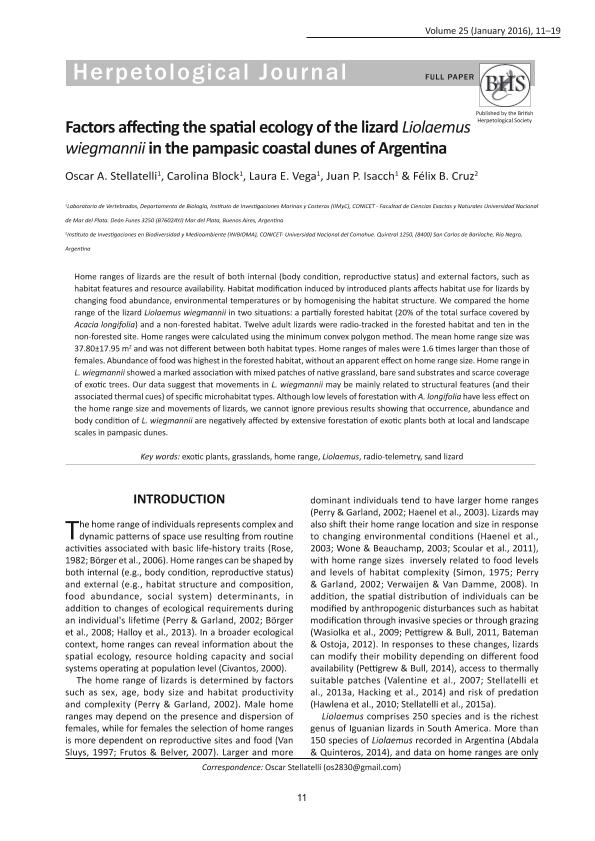Mostrar el registro sencillo del ítem
dc.contributor.author
Stellatelli, Oscar Aníbal

dc.contributor.author
Block, Carolina

dc.contributor.author
Vega, Laura Estela

dc.contributor.author
Isacch, Juan Pablo

dc.contributor.author
Cruz, Felix Benjamin

dc.date.available
2018-11-02T18:57:50Z
dc.date.issued
2016-01
dc.identifier.citation
Stellatelli, Oscar Aníbal; Block, Carolina; Vega, Laura Estela; Isacch, Juan Pablo; Cruz, Felix Benjamin; Factors affecting the spatial ecology of the lizard Liolaemus wiegmannii in the pampasic coastal dunes of Argentina; British Herpetological Society; Herpetological Journal; 26; 1; 1-2016; 11-19
dc.identifier.issn
0268-0130
dc.identifier.uri
http://hdl.handle.net/11336/63530
dc.description.abstract
Home ranges of lizards are the result of both internal (body condition, reproductive status) and external factors, such as habitat features and resource availability. Habitat modification induced by introduced plants affects habitat use for lizards by changing food abundance, environmental temperatures or by homogenizing the habitat structure. We compared the home range of the lizard Liolaemus wiegmannii in two situations: a partially forested habitat (20% of the total surface covered by Acacia longifolia) and a non-forested habitat. Twelve adult lizards were radio-tracked in the forested habitat and ten in the non-forested site. Home ranges were calculated using the minimum convex polygon method. The mean home range size was 37.80±17.95 m2 and was not different between both habitat types. Males home ranges were 1.6 times larger than those of females. Abundance of food was highest in the forested habitat, nonetheless, its effect on home range size was not evident. Home range in L. wiegmannii showed a marked association with mixed patches of native grassland, bare sand substrates and scarce coverage of exotic trees. Our data suggest that movements in L. wiegmannii may be mainly related to structural features (and their associated thermal cues) of specific microhabitats types. Although low levels of forestation with A. longifolia have less effect on the home range size and movements of lizards, we cannot ignore previous results showing that occurrence, abundance, and body condition of L. wiegmannii are negatively affected by extensive forestation of exotic plants both at local and landscape scales in pampasic dunes.
dc.format
application/pdf
dc.language.iso
eng
dc.publisher
British Herpetological Society

dc.rights
info:eu-repo/semantics/openAccess
dc.rights.uri
https://creativecommons.org/licenses/by-nc-sa/2.5/ar/
dc.subject
Liolaemus
dc.subject
Sand-Lizard
dc.subject
Radio-Telemetry
dc.subject
Home Range
dc.subject.classification
Otras Ciencias Biológicas

dc.subject.classification
Ciencias Biológicas

dc.subject.classification
CIENCIAS NATURALES Y EXACTAS

dc.title
Factors affecting the spatial ecology of the lizard Liolaemus wiegmannii in the pampasic coastal dunes of Argentina
dc.type
info:eu-repo/semantics/article
dc.type
info:ar-repo/semantics/artículo
dc.type
info:eu-repo/semantics/publishedVersion
dc.date.updated
2018-09-24T14:12:42Z
dc.journal.volume
26
dc.journal.number
1
dc.journal.pagination
11-19
dc.journal.pais
Reino Unido

dc.description.fil
Fil: Stellatelli, Oscar Aníbal. Consejo Nacional de Investigaciones Científicas y Técnicas. Centro Científico Tecnológico Conicet - Mar del Plata. Instituto de Investigaciones Marinas y Costeras. Universidad Nacional de Mar del Plata. Facultad de Ciencia Exactas y Naturales. Instituto de Investigaciones Marinas y Costeras; Argentina
dc.description.fil
Fil: Block, Carolina. Consejo Nacional de Investigaciones Científicas y Técnicas. Centro Científico Tecnológico Conicet - Mar del Plata. Instituto de Investigaciones Marinas y Costeras. Universidad Nacional de Mar del Plata. Facultad de Ciencia Exactas y Naturales. Instituto de Investigaciones Marinas y Costeras; Argentina
dc.description.fil
Fil: Vega, Laura Estela. Consejo Nacional de Investigaciones Científicas y Técnicas. Centro Científico Tecnológico Conicet - Mar del Plata. Instituto de Investigaciones Marinas y Costeras. Universidad Nacional de Mar del Plata. Facultad de Ciencia Exactas y Naturales. Instituto de Investigaciones Marinas y Costeras; Argentina
dc.description.fil
Fil: Isacch, Juan Pablo. Consejo Nacional de Investigaciones Científicas y Técnicas. Centro Científico Tecnológico Conicet - Mar del Plata. Instituto de Investigaciones Marinas y Costeras. Universidad Nacional de Mar del Plata. Facultad de Ciencia Exactas y Naturales. Instituto de Investigaciones Marinas y Costeras; Argentina
dc.description.fil
Fil: Cruz, Felix Benjamin. Consejo Nacional de Investigaciones Científicas y Técnicas. Centro Científico Tecnológico Conicet - Patagonia Norte. Instituto de Investigaciones en Biodiversidad y Medioambiente. Universidad Nacional del Comahue. Centro Regional Universidad Bariloche. Instituto de Investigaciones en Biodiversidad y Medioambiente; Argentina
dc.journal.title
Herpetological Journal

dc.relation.alternativeid
info:eu-repo/semantics/altIdentifier/url/https://www.ingentaconnect.com/contentone/bhs/thj/2016/00000026/00000001/art00003
Archivos asociados
